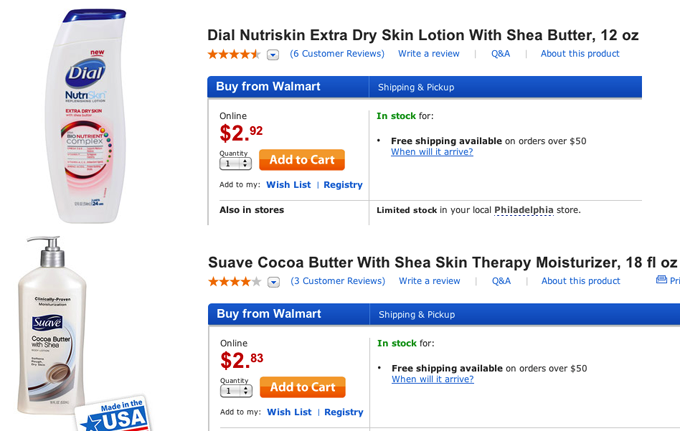Walmart, CVS, Walgreens, Costco Agree To Finally Put Unit Pricing Online

Without the unit pricing info, one might not see the huge difference in value between these two similar products on Walmart.com.
New York state Attorney General Eric “Peter Parker” Schneiderman announced this morning that national retailers Walmart, Costco, Walgreens, CVS and Drugstore.com, along with NYC-based grocery delivery service FreshDirect, agreed to start placing unit prices on all applicable products within the next year.
For example, if you go to Walmart.com and you’re looking for hand lotion with shea butter, you might see this Dial product for $2.92 and this Suave item for $2.83.
The nine-cent price difference between the two items might seem negligible, especially if you don’t notice that the Suave bottle contains 18 ounces of lotion while the Dial is only 12 ounces. Given that the packaging of these two items is very different and one can’t do the side-by-side comparison that one might do in a grocery store, it’s entirely possible that one might assume they are the same size and thus providing around the same value.
But if Walmart.com had unit pricing under the sticker price, you’d see a substantial difference in value. The Dial product sells for $.243/oz., while the Suave lotion goes for $.157/oz, or around 2/3 of the unit price of the Dial lotion.
New York is one of the 19 states (plus Washington, D.C.) that has at least some law requiring unit pricing on retail goods, so these retailers are already making this information available in those locations. And some e-tailers — like FreshDirect competitor Peapod — already have unit pricing on their websites, so it makes competitive sense that these businesses would also want to look like they give a damn about informing consumers.
“As the Internet becomes the shopping mall of the 21st century, we need to ensure that consumers have the same robust protections online that they do in brick-and-mortar stores,” said Schneiderman.
While the agreement was made with Schneiderman’s office in Albany, the changes will be felt nationwide.
Walmart and Costco will provide unit pricing information on all their websites and mobile stores in the U.S. by the end of 2014.
Walgreens, FreshDirect, CVS and Drugstore.com have agreed to a slightly longer timeline, giving themselves until March, 2015.
The biggest player absent from this agreement is Amazon, which does provide unit pricing on a number of items, including its currently paltry Prime Pantry selection, but not uniformly. Nor does Amazon post unit pricing on all the subsidiary websites it operates.
Schneiderman says Amazon verbally agreed to add unit pricing to stores operated by its Quidsi subsidiary — like Diapers.com, Soap.com, BeautyBar.com — but that Amazon refused to put this agreement in writing.
Want more consumer news? Visit our parent organization, Consumer Reports, for the latest on scams, recalls, and other consumer issues.

